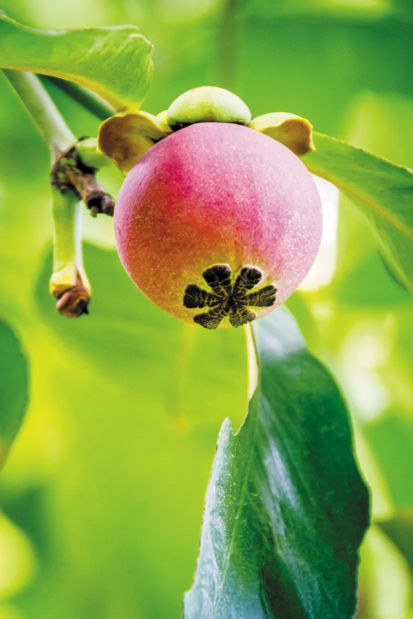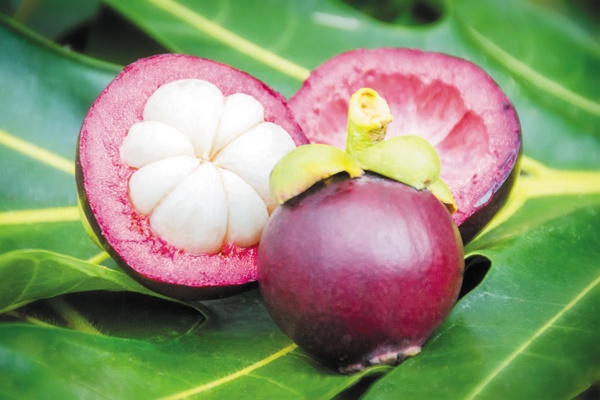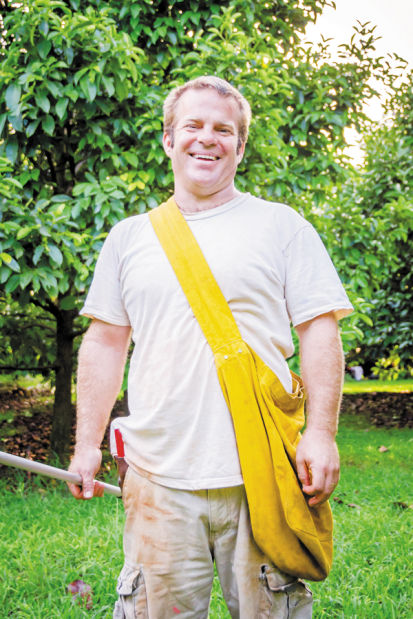Brad and Amy Smith grow exotic fruit on 30 acres, and vegetables on 1/4-acre in Moloaa. Amy makes soap with mangosteen from the family farm and enriches it with a blend of olive and coconut oils. Gritty bits of dehydrated
Brad and Amy Smith grow exotic fruit on 30 acres, and vegetables on 1/4-acre in Moloaa. Amy makes soap with mangosteen from the family farm and enriches it with a blend of olive and coconut oils. Gritty bits of dehydrated skin are added to exfoliate and brighten skin.
What’s growing:
Asparagus, avocados, atamoya, beets, carrots, chicu, cilantro, cream apple, jackfruit, kale, lettuce, longan, lychee, mangosteen, onions (bulbing), rambutan, pak choy, parsley, pineapple, star fruit, tomatoes.
Mangosteen
Personally, I think mangosteen is the cutest fruit around. A fat, light green stem is tucked between four plump, stiff leaves, which sit on top of a round, purple shell. Underneath, four to eight pudgy stigma lobes look like a 1960s flower. Inside, the number of creamy white sections always corresponds to the number of petals on that 1960s flower. The rind is bitter from tannins and best used as a medicinal tea. The flesh is sweet, slightly acidic and exquisitely luscious.
The ultra-tropical fruit is believed to have originated in the Sunda Islands and is reported to have been Queen Victoria’s favorite fruit. It’s pretty rare on Kauai, due to subtropical conditions, but the Smiths are able to grow it on their North Shore farm. Since mangosteen trees take 10 years to bear fruit, prices range between $10 and $15 a pound.
Season: On Kauai, fruit can be available for six weeks around March and again in December. Brad cautions that Mother Nature has total control over fruit availability.
What to look for
Select firm mangosteen with a deep purple color. The fruit should give slightly with light pressure. Dry, wilted leaves indicate dry fruit.
Storage
Mangosteen will keep for up to one week if stored on a counter out of sunlight. Stored in the refrigerator, it will last up to three weeks. The shell can be frozen and used as needed.
Tip
To select the best table fruits, choose those with the highest number of stigma lobes at the apex, because these have the highest number of fleshy segments and accordingly the fewest seeds.
Preparation
Mangosteens are usually eaten fresh as dessert. Cut mangosteen around the diameter, making sure to not slice into the fruit inside. Take the top half of the rind off and use the bottom as a “cup”. Gingerly remove flesh with a fork and pop into your mouth. Crush one quarter of the shell and steep in hot filtered water for 10 minutes. Add sweetener to your taste.
Health benefits
Antioxidants and xanthones in the mangosteen rind contain antibacterial, anti-fungal, and anti-microbial properties. Mangosteen soap helps alleviate acne, eczema, rashes, small wounds, and other skin conditions. Historically, the fruit, fruit juice, rind, twig, and bark are used medicinally to treat diarrhea, urinary tract infections (UTIs), gonorrhea, thrush, tuberculosis, menstrual disorders, cancer, osteoarthritis and intestinal infections. It is also used for stimulating the immune system and improving mental health. Few scientific studies have been conducted to validate these claims.
Viva Rain produce can be found at
Grocery: Banana Joe’s Fruitstand, Papaya’s Natural Foods and Cafe, Harvest Market. Farmers Market: Waipa, Tuesdays at 2 p.m, Kapaa Wednesdays at 3 p.m., Kilauea, Thursdays at 4:30 p.m., Namahana, Saturdays at 9 a.m., Hanalei, Saturdays 9:30 a.m. For more information call 346-3299 or email JusKruisin@hotmail.com. For more on Amy’s mangosteen soap, visit utara-soap.com.
• Marta Lane, a food writer on Kauai since 2010, offers farm to fork food tours and is the author of Tasting Kauai: Restaurants – From Food Trucks to Fine Dining, A Guide to Eating Well on the Garden Island. For more information, visit TastingKauai.com




